bulb CHEVROLET TRAIL BLAZER 2007 1.G Owners Manual
[x] Cancel search | Manufacturer: CHEVROLET, Model Year: 2007, Model line: TRAIL BLAZER, Model: CHEVROLET TRAIL BLAZER 2007 1.GPages: 574, PDF Size: 2.94 MB
Page 2 of 574
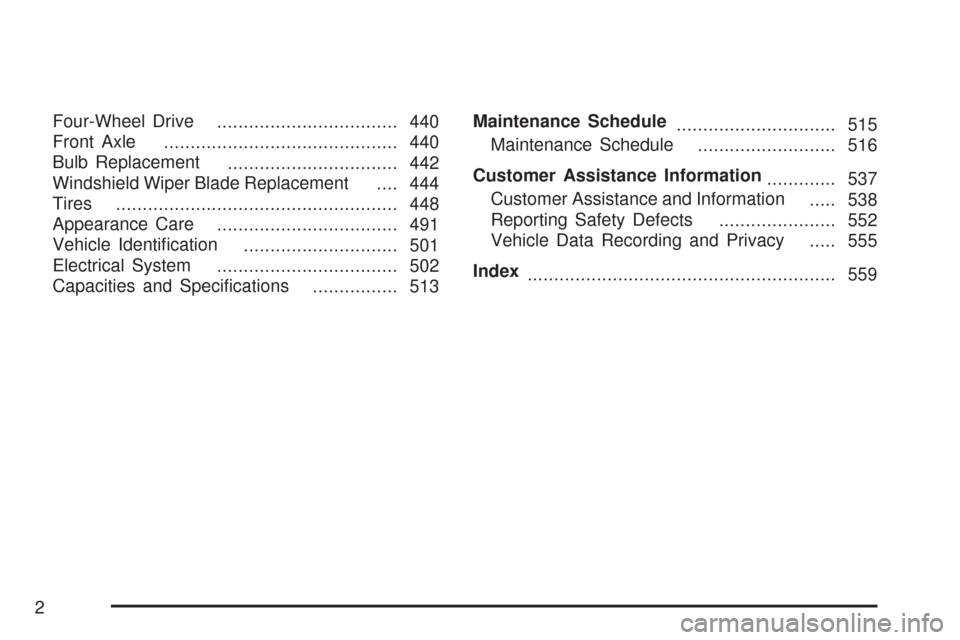
Four-Wheel Drive
.................................. 440
Front Axle
............................................ 440
Bulb Replacement
................................ 442
Windshield Wiper Blade Replacement
.... 444
Tires
..................................................... 448
Appearance Care
.................................. 491
Vehicle Identi�cation
............................. 501
Electrical System
.................................. 502
Capacities and Speci�cations
................ 513Maintenance Schedule
.............................. 515
Maintenance Schedule
.......................... 516
Customer Assistance Information
............. 537
Customer Assistance and Information
..... 538
Reporting Safety Defects
...................... 552
Vehicle Data Recording and Privacy
..... 555
Index
.......................................................... 559
2
Page 174 of 574

Turn and Lane-Change Signals
The turn signal has two upward (for right) and
two downward (for left) positions. These positions
let you signal a turn or a lane change.
To signal a turn, move the lever all the way up
or down. When the turn is �nished, the lever
returns automatically.
An arrow on the
instrument panel
cluster �ashes in the
direction of the turn
or lane change.
To signal a lane change, raise or lower the lever
until the arrow starts to �ash. Hold it there until you
complete your lane change. The lever returns
by itself when released. The bottom of the outside
rearview mirrors might also have lane change
indicators.As you signal a turn or a lane change, if the
arrows �ash more quickly than normal, a signal
bulb could be burned out and other drivers will not
see your turn signal.
If a bulb is burned out, replace it to help avoid an
accident. If the arrows do not go on at all when
you signal a turn, check the fuse. SeeFuses
and Circuit Breakers on page 503and check for
burned-out bulbs.
If you have a trailer towing option with added
wiring for the trailer lamps, a turn signal �asher
is used. With this �asher installed, the signal
indicator �ashes even if a turn signal bulb
is burned out. Check the front and rear turn signal
lamps regularly to make sure they are working.
Turn Signal On Chime
If your turn signal is left on for more than
3/4 of a mile (1.2 km), a chime sounds at each
�ash of the turn signal. To turn off the chime,
move the turn signal lever to the off position.
174
Page 378 of 574
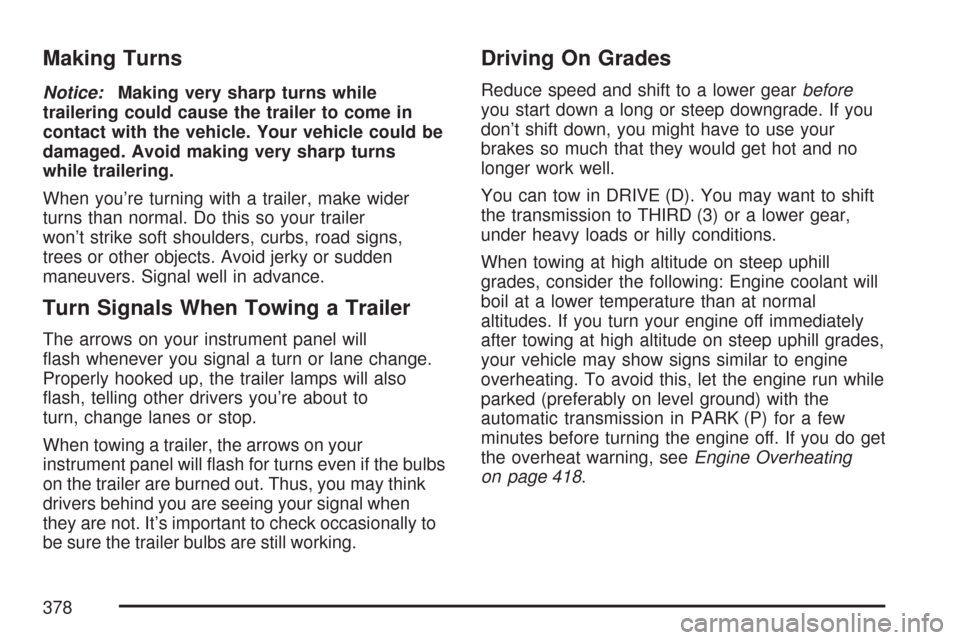
Making Turns
Notice:Making very sharp turns while
trailering could cause the trailer to come in
contact with the vehicle. Your vehicle could be
damaged. Avoid making very sharp turns
while trailering.
When you’re turning with a trailer, make wider
turns than normal. Do this so your trailer
won’t strike soft shoulders, curbs, road signs,
trees or other objects. Avoid jerky or sudden
maneuvers. Signal well in advance.
Turn Signals When Towing a Trailer
The arrows on your instrument panel will
�ash whenever you signal a turn or lane change.
Properly hooked up, the trailer lamps will also
�ash, telling other drivers you’re about to
turn, change lanes or stop.
When towing a trailer, the arrows on your
instrument panel will �ash for turns even if the bulbs
on the trailer are burned out. Thus, you may think
drivers behind you are seeing your signal when
they are not. It’s important to check occasionally to
be sure the trailer bulbs are still working.
Driving On Grades
Reduce speed and shift to a lower gearbefore
you start down a long or steep downgrade. If you
don’t shift down, you might have to use your
brakes so much that they would get hot and no
longer work well.
You can tow in DRIVE (D). You may want to shift
the transmission to THIRD (3) or a lower gear,
under heavy loads or hilly conditions.
When towing at high altitude on steep uphill
grades, consider the following: Engine coolant will
boil at a lower temperature than at normal
altitudes. If you turn your engine off immediately
after towing at high altitude on steep uphill grades,
your vehicle may show signs similar to engine
overheating. To avoid this, let the engine run while
parked (preferably on level ground) with the
automatic transmission in PARK (P) for a few
minutes before turning the engine off. If you do get
the overheat warning, seeEngine Overheating
on page 418.
378
Page 383 of 574
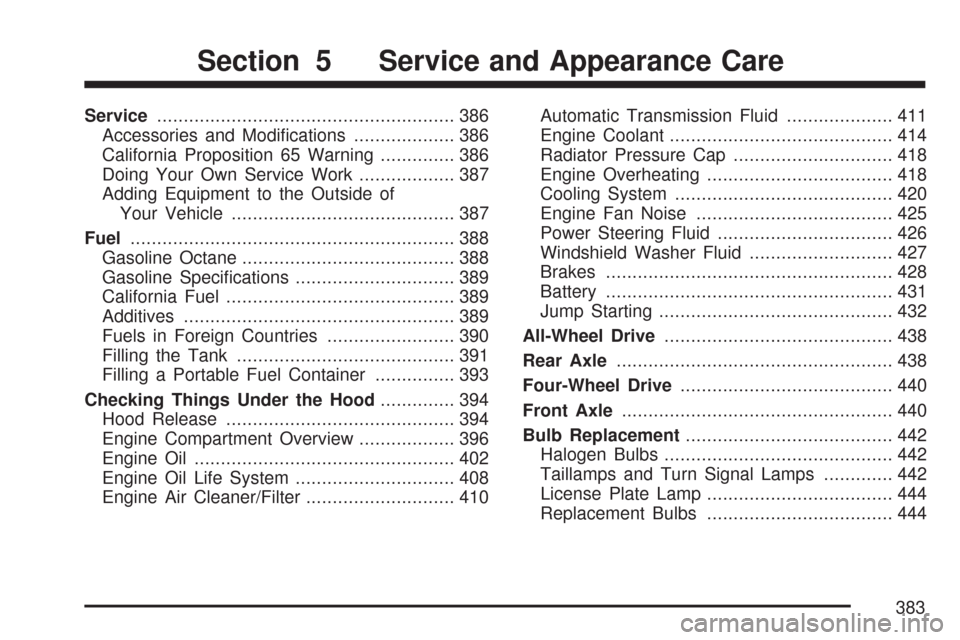
Service........................................................ 386
Accessories and Modi�cations................... 386
California Proposition 65 Warning.............. 386
Doing Your Own Service Work.................. 387
Adding Equipment to the Outside of
Your Vehicle.......................................... 387
Fuel............................................................. 388
Gasoline Octane........................................ 388
Gasoline Speci�cations.............................. 389
California Fuel........................................... 389
Additives................................................... 389
Fuels in Foreign Countries........................ 390
Filling the Tank......................................... 391
Filling a Portable Fuel Container............... 393
Checking Things Under the Hood.............. 394
Hood Release........................................... 394
Engine Compartment Overview.................. 396
Engine Oil................................................. 402
Engine Oil Life System.............................. 408
Engine Air Cleaner/Filter............................ 410Automatic Transmission Fluid.................... 411
Engine Coolant.......................................... 414
Radiator Pressure Cap.............................. 418
Engine Overheating................................... 418
Cooling System......................................... 420
Engine Fan Noise..................................... 425
Power Steering Fluid................................. 426
Windshield Washer Fluid........................... 427
Brakes...................................................... 428
Battery...................................................... 431
Jump Starting............................................ 432
All-Wheel Drive........................................... 438
Rear Axle.................................................... 438
Four-Wheel Drive........................................ 440
Front Axle................................................... 440
Bulb Replacement....................................... 442
Halogen Bulbs........................................... 442
Taillamps and Turn Signal Lamps............. 442
License Plate Lamp................................... 444
Replacement Bulbs................................... 444
Section 5 Service and Appearance Care
383
Page 442 of 574
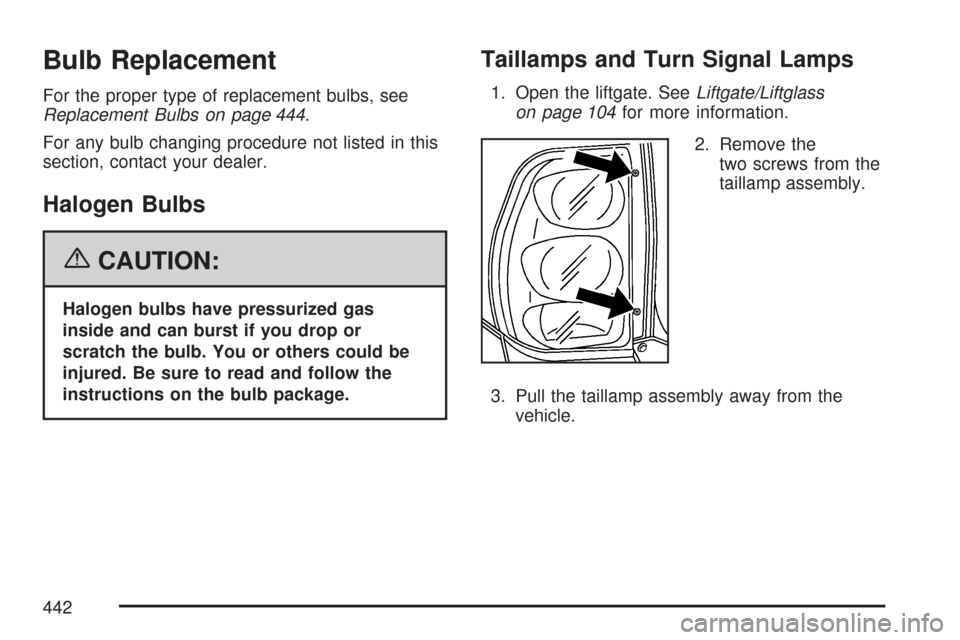
Bulb Replacement
For the proper type of replacement bulbs, see
Replacement Bulbs on page 444.
For any bulb changing procedure not listed in this
section, contact your dealer.
Halogen Bulbs
{CAUTION:
Halogen bulbs have pressurized gas
inside and can burst if you drop or
scratch the bulb. You or others could be
injured. Be sure to read and follow the
instructions on the bulb package.
Taillamps and Turn Signal Lamps
1. Open the liftgate. SeeLiftgate/Liftglass
on page 104for more information.
2. Remove the
two screws from the
taillamp assembly.
3. Pull the taillamp assembly away from the
vehicle.
442
Page 443 of 574

4. Unclip the wiring harness (A) and remove the
three retaining screws (B) from the socket
plate.
5. Remove the socket plate.6. Holding the socket, pull the bulb to release it
from the socket.
7. Push the new bulb into the socket until it
clicks.
8. Reinstall the socket and tighten the
three screws.
9. Reconnect the wiring harness.
10. Reinstall the taillamp assembly by lining up
the locator pins with the retainers in the
vehicle’s body.
11. Reinstall the two screws and tighten.
12. Close the liftgate.
443
Page 444 of 574
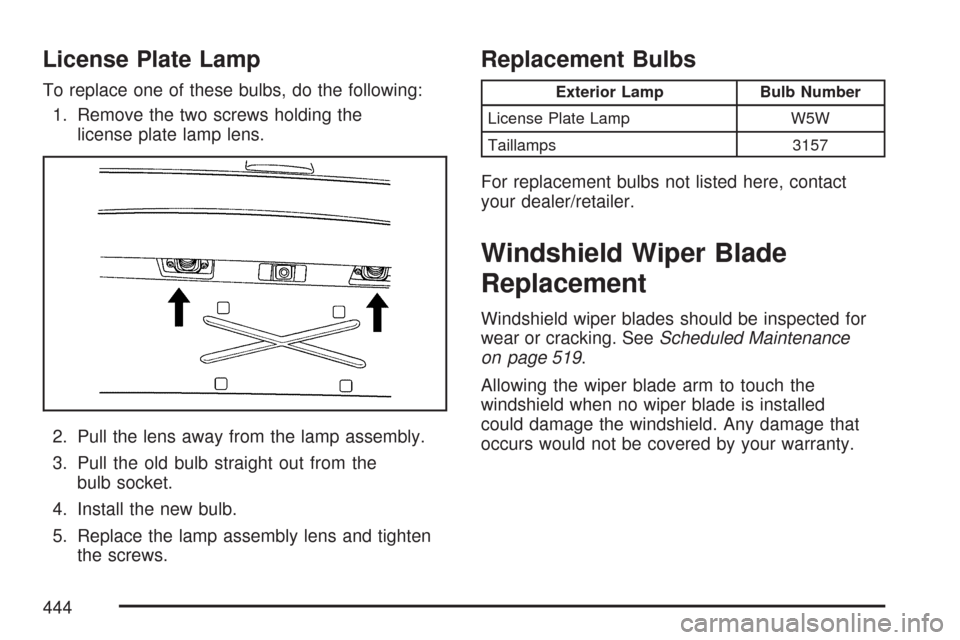
License Plate Lamp
To replace one of these bulbs, do the following:
1. Remove the two screws holding the
license plate lamp lens.
2. Pull the lens away from the lamp assembly.
3. Pull the old bulb straight out from the
bulb socket.
4. Install the new bulb.
5. Replace the lamp assembly lens and tighten
the screws.
Replacement Bulbs
Exterior Lamp Bulb Number
License Plate Lamp W5W
Taillamps 3157
For replacement bulbs not listed here, contact
your dealer/retailer.
Windshield Wiper Blade
Replacement
Windshield wiper blades should be inspected for
wear or cracking. SeeScheduled Maintenance
on page 519.
Allowing the wiper blade arm to touch the
windshield when no wiper blade is installed
could damage the windshield. Any damage that
occurs would not be covered by your warranty.
444
Page 560 of 574

Appearance Care (cont.)
Windshield, Backglass, and Wiper
Blades.................................................. 497
Ashtray....................................................... 187
Audio System.............................................. 238
Audio Steering Wheel Controls................. 300
Care of Your CD and DVD Player............ 302
Care of Your CDs and DVDs................... 302
Chime Level Adjustment........................... 303
Fixed Mast Antenna................................. 303
Navigation/Radio System, see
Navigation Manual................................ 284
Radio with CD................................240, 250
Radio with Six-Disc CD............................ 260
Rear Seat Audio (RSA)............................ 298
Setting the Time...................................... 239
Theft-Deterrent Feature............................ 300
Understanding Radio Reception............... 301
XM™ Satellite Radio Antenna System...... 303
Automatic Headlamp System....................... 182
Automatic Transmission
Fluid........................................................ 411
Operation................................................. 117B
Battery........................................................ 431
Electric Power Management..................... 185
Run-Down Protection............................... 186
Before Leaving on a Long Trip.................... 346
Brake
Emergencies............................................ 313
Parking.................................................... 126
Brakes........................................................ 428
System Warning Light.............................. 208
Braking....................................................... 310
Braking in Emergencies............................... 313
Break-In, New Vehicle................................. 111
Bulb Replacement....................................... 442
Halogen Bulbs......................................... 442
License Plate Lamps................................ 444
Replacement Bulbs.................................. 444
Taillamps and Turn Signal Lamps............. 442
Buying New Tires........................................ 466
560
Page 565 of 574
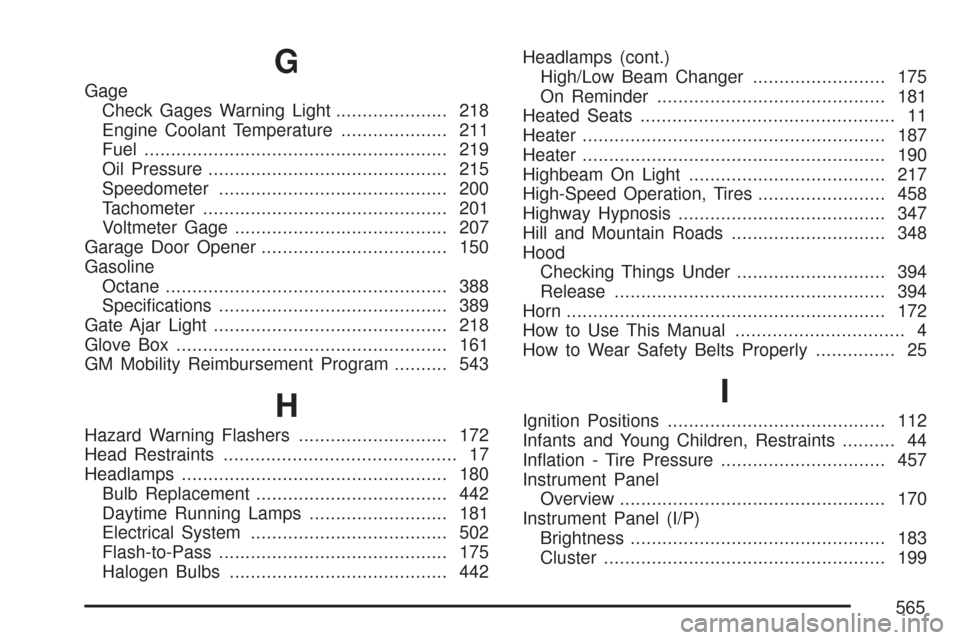
G
Gage
Check Gages Warning Light..................... 218
Engine Coolant Temperature.................... 211
Fuel......................................................... 219
Oil Pressure............................................. 215
Speedometer........................................... 200
Tachometer.............................................. 201
Voltmeter Gage........................................ 207
Garage Door Opener................................... 150
Gasoline
Octane..................................................... 388
Speci�cations........................................... 389
Gate Ajar Light............................................ 218
Glove Box................................................... 161
GM Mobility Reimbursement Program.......... 543
H
Hazard Warning Flashers............................ 172
Head Restraints............................................ 17
Headlamps.................................................. 180
Bulb Replacement.................................... 442
Daytime Running Lamps.......................... 181
Electrical System..................................... 502
Flash-to-Pass........................................... 175
Halogen Bulbs......................................... 442Headlamps (cont.)
High/Low Beam Changer......................... 175
On Reminder........................................... 181
Heated Seats................................................ 11
Heater......................................................... 187
Heater......................................................... 190
Highbeam On Light..................................... 217
High-Speed Operation, Tires........................ 458
Highway Hypnosis....................................... 347
Hill and Mountain Roads............................. 348
Hood
Checking Things Under............................ 394
Release................................................... 394
Horn............................................................ 172
How to Use This Manual................................ 4
How to Wear Safety Belts Properly............... 25
I
Ignition Positions......................................... 112
Infants and Young Children, Restraints.......... 44
In�ation - Tire Pressure............................... 457
Instrument Panel
Overview.................................................. 170
Instrument Panel (I/P)
Brightness................................................ 183
Cluster..................................................... 199
565
Page 570 of 574
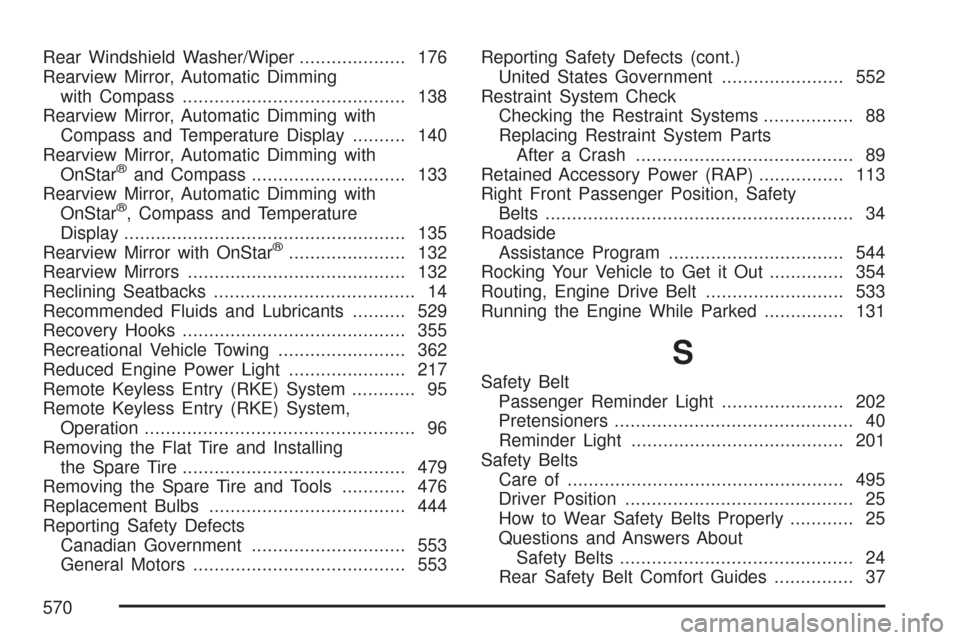
Rear Windshield Washer/Wiper.................... 176
Rearview Mirror, Automatic Dimming
with Compass.......................................... 138
Rearview Mirror, Automatic Dimming with
Compass and Temperature Display.......... 140
Rearview Mirror, Automatic Dimming with
OnStar
®and Compass............................. 133
Rearview Mirror, Automatic Dimming with
OnStar
®, Compass and Temperature
Display..................................................... 135
Rearview Mirror with OnStar
®...................... 132
Rearview Mirrors......................................... 132
Reclining Seatbacks...................................... 14
Recommended Fluids and Lubricants.......... 529
Recovery Hooks.......................................... 355
Recreational Vehicle Towing........................ 362
Reduced Engine Power Light...................... 217
Remote Keyless Entry (RKE) System............ 95
Remote Keyless Entry (RKE) System,
Operation................................................... 96
Removing the Flat Tire and Installing
the Spare Tire.......................................... 479
Removing the Spare Tire and Tools............ 476
Replacement Bulbs..................................... 444
Reporting Safety Defects
Canadian Government............................. 553
General Motors........................................ 553Reporting Safety Defects (cont.)
United States Government....................... 552
Restraint System Check
Checking the Restraint Systems................. 88
Replacing Restraint System Parts
After a Crash......................................... 89
Retained Accessory Power (RAP)................ 113
Right Front Passenger Position, Safety
Belts.......................................................... 34
Roadside
Assistance Program................................. 544
Rocking Your Vehicle to Get it Out.............. 354
Routing, Engine Drive Belt.......................... 533
Running the Engine While Parked............... 131
S
Safety Belt
Passenger Reminder Light....................... 202
Pretensioners............................................. 40
Reminder Light........................................ 201
Safety Belts
Care of.................................................... 495
Driver Position........................................... 25
How to Wear Safety Belts Properly............ 25
Questions and Answers About
Safety Belts............................................ 24
Rear Safety Belt Comfort Guides............... 37
570